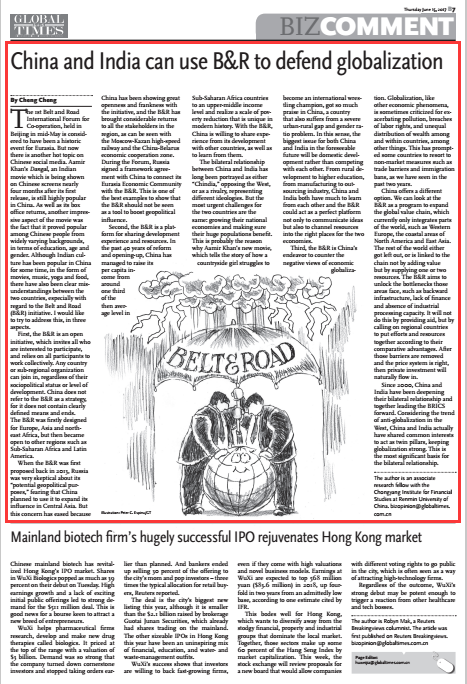Belt and Road
Your Present Location: PROGRAMS> Belt and RoadCheng Cheng: China and India can use B&R to defend globalization
By Cheng Cheng Source: Global Times Published: 2017-6-14
The 1st Belt and Road International Forum for Co-operation, held in Beijing in mid-May is considered to have been a historic event for Eurasia. But now there is another hot topic on Chinese social media. Aamir Khan`s Dangal, an Indian movie which is being shown on Chinese screens nearly four months after its first release, is still highly popular in China. As well as its box office returns, another impressive aspect of the movie was the fact that it proved popular among Chinese people from widely varying backgrounds, in terms of education, age and gender. Although Indian culture has been popular in China for some time, in the form of movies, music, yoga and food, there have also been clear misunderstandings between the two countries, especially with regard to the Belt and Road (B&R) initiative. I would like to try to address this, in three aspects.

First, the B&R is an open initiative, which invites all who are interested to participate, and relies on all participants to work collectively. Any country or sub-regional organization can join in, regardless of their sociopolitical status or level of development. China does not refer to the B&R as a strategy, for it does not contain clearly defined means and ends. The B&R was firstly designed for Europe, Asia and northeast Africa, but then became open to other regions such as Sub-Saharan Africa and Latin America.
When the B&R was first proposed back in 2013, Russia was very skeptical about its "potential geopolitical purposes," fearing that China planned to use it to expand its influence in Central Asia. But this concern has eased because China has been showing great openness and frankness with the initiative, and the B&R has brought considerable returns to all the stakeholders in the region, as can be seen with the Moscow-Kazan high-speed railway and the China-Belarus economic cooperation zone. During the Forum, Russia signed a framework agreement with China to connect its Eurasia Economic Community with the B&R. This is one of the best examples to show that the B&R should not be seen as a tool to boost geopolitical influence.
Second, the B&R is a platform for sharing development experience and resources. In the past 40 years of reform and opening-up, China has managed to raise its per capita income from around one third of the then average level in Sub-Saharan Africa countries to an upper-middle income level and realize a scale of poverty reduction that is unique in modern history. With the B&R, China is willing to share experience from its development with other countries, as well as to learn from them.
The bilateral relationship between China and India has long been portrayed as either "Chindia," opposing the West, or as a rivalry, representing different ideologies. But the most urgent challenges for the two countries are the same: growing their national economies and making sure their huge populations benefit. This is probably the reason why Aamir Khan`s new movie, which tells the story of how a countryside girl struggles to become an international wrestling champion, got so much praise in China, a country that also suffers from a severe urban-rural gap and gender ratio problem. In this sense, the biggest issue for both China and India in the foreseeable future will be domestic development rather than competing with each other. From rural development to higher education, from manufacturing to out-sourcing industry, China and India both have much to learn from each other and the B&R could act as a perfect platform not only to communicate ideas but also to channel resources into the right places for the two economies.
Third, the B&R is China`s endeavor to counter the negative views of economic globalization. Globalization, like other economic phenomena, is sometimes criticized for exacerbating pollution, breaches of labor rights, and unequal distribution of wealth among and within countries, among other things. This has prompted some countries to resort to non-market measures such as trade barriers and immigration bans, as we have seen in the past two years.
China offers a different option. We can look at the B&R as a program to expand the global value chain, which currently only integrates parts of the world, such as Western Europe, the coastal areas of North America and East Asia. The rest of the world either got left out, or is linked to the chain not by adding value but by supplying one or two resources. The B&R aims to unlock the bottlenecks those areas face, such as backward infrastructure, lack of finance and absence of industrial processing capacity. It will not do this by providing aid, but by calling on regional countries to put efforts and resources together according to their comparative advantages. After those barriers are removed and the price system is right, then private investment will naturally flow in.
Since 2000, China and India have been deepening their bilateral relationship and together leading the BRICS forward. Considering the trend of anti-globalization in the West, China and India actually have shared common interests to act as twin pillars, keeping globalization strong. This is the most significant basis for the bilateral relationship.
The author is an associate research fellow with the Chongyang Institute for Financial Studies at Renmin University of China.
Key Words: China; India; Belt and Road























































































 京公网安备 11010802037854号
京公网安备 11010802037854号





